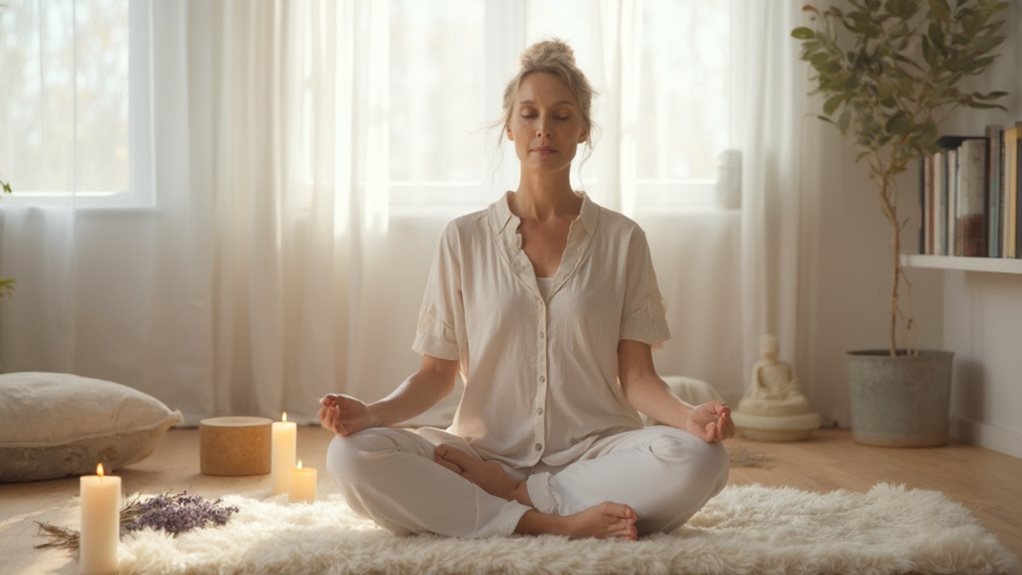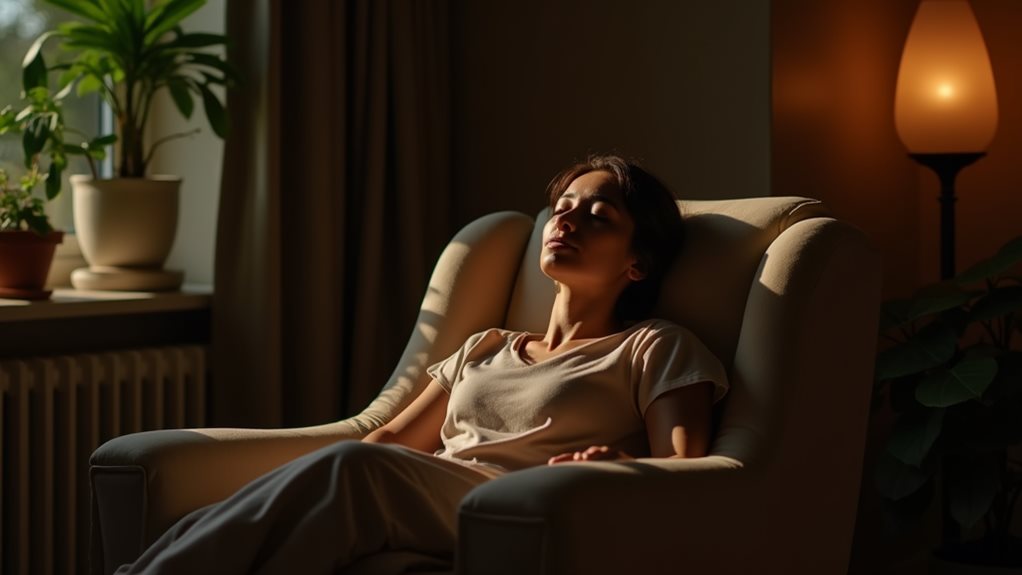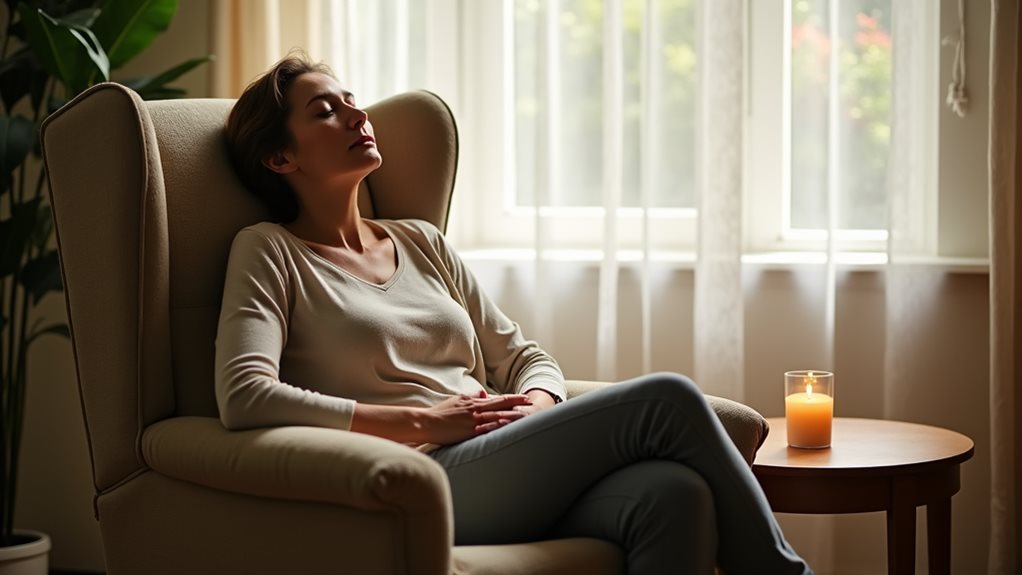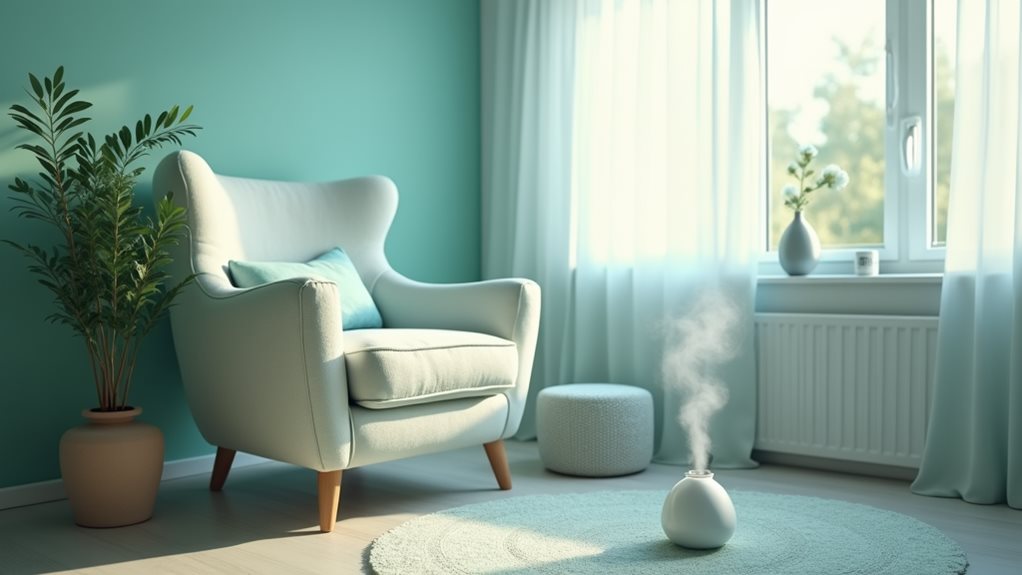
Self-hypnosis is a valuable method for achieving deep relaxation, effectively reducing stress and enhancing overall well-being. This technique involves focused breathing, visualization of serene environments, and repetition of calming affirmations, allowing individuals to access a tranquil state of mind. Regular practice not only promotes mental clarity but also improves sleep quality. By mastering self-hypnosis, one can nurture a balanced connection between mind and body, paving the way to discover further techniques for maintaining holistic health.
Key Takeaways
- Utilize focused breathing to ease into a state of deep relaxation through self-hypnosis.
- Engage in progressive muscle relaxation to enhance body awareness and release tension.
- Practice visualization techniques, imagining serene environments to foster calmness.
- Repeat calming affirmations to access and influence the subconscious mind.
- Incorporate autogenic training by focusing on bodily sensations and affirmations for stress relief.
Exploring the Benefits of Self-Hypnosis for Relaxation
Exploring the benefits of self-hypnosis for relaxation reveals a multitude of advantages for both mental and physical health. This technique effectively reduces stress and anxiety by guiding individuals toward a tranquil state of mind, thereby promoting emotional release.
It enhances sleep quality and duration, which is vital for overall well-being. Regular practice nurtures a harmonious balance between the mind and body, fostering a profound sense of relaxation incorporated into daily routines.
As individuals achieve deeper relaxation, they experience significant improvement in mental clarity, which supports a peaceful and productive lifestyle. Overall, self-hypnosis benefits are essential for maintaining holistic health.
Essential Techniques for Self-Induced Hypnosis
Having established the benefits of self-hypnosis for relaxation, it is now appropriate to outline the specific techniques that facilitate self-induced hypnosis.
Addressing self-hypnosis myths is vital; many erroneously believe it requires expert intervention, yet individuals can effectively induce a hypnotic state themselves. Overcoming resistance involves recognizing and dispelling these misconceptions.
Techniques such as focused breathing, visualization of serene environments, and repetition of calming affirmations help in achieving deeper relaxation states.
Mastery of these methods enhances the ability to access the subconscious, thereby improving mental well-being and stress management through regular self-hypnosis practice.
Mastering Progressive Muscle Relaxation

Progressive Muscle Relaxation (PMR) stands as a cornerstone technique in self-hypnosis, effectively aiding individuals in achieving a deeper state of calm.
This method involves the sequential tensing and relaxing of different muscle groups, enhancing muscle awareness and progressive relaxation. By focusing attentively on the contrast between tension and relaxation, practitioners develop a heightened awareness of bodily sensations, which contributes to overall stress reduction.
Regular practice of PMR can greatly improve relaxation and manage anxiety, promoting a serene mind and body connection.
It is a valuable skill for anyone seeking to deepen their self-hypnosis experience and achieve sustained relaxation.
The Power of Visualization in Achieving Calm
Building on the foundation of Progressive Muscle Relaxation, the practice of visualization offers another robust tool in self-hypnosis aimed at cultivating calmness.
This technique leverages the power of mental imagery to form peaceful scenes in the mind's eye, effectively reducing stress and promoting a serene state of being.
Visualization benefits are vast, enhancing the relaxation response by connecting the mental and physical domains.
Individuals engage in creating detailed, vivid images that evoke tranquility, reinforcing the mind-body link and deepening relaxation.
Regular practice of this method not only fosters calm but also improves overall mental health and well-being.
How Autogenic Training Facilitates Deep Relaxation

Autogenic training, a self-hypnosis technique developed by the German psychiatrist Johannes Heinrich Schultz, is highly effective in facilitating deep relaxation. This method leverages the power of self-suggestion to achieve stress reduction and a state of calm.
The principles of autogenic training are straightforward yet profound:
- Repetition: Engages the mind through repeated affirmations that focus on bodily sensations of heaviness and warmth.
- Focus: Concentrates on physical sensations to disconnect from stressful thoughts.
- Empowerment: Encourages self-regulation of the autonomic nervous system, promoting a natural relaxation response.
Autogenic training consequently serves as a robust tool for managing stress and enhancing well-being.
Step-by-Step Guide to Effective Self-Hypnosis
To commence the journey of self-hypnosis, it is essential first to create a conducive environment that promotes relaxation and minimizes distractions.
Begin by focusing on deep, rhythmic breathing to stabilize your physical and mental state. Gradually engage in progressive muscle relaxation, consciously releasing tension from each muscle group. This preparation enhances self-awareness benefits, vital for deeper subconscious access.
Shift into visualization, picturing a serene location that embodies tranquility. Here, employ positive affirmations that resonate with personal aspirations and emotional healing.
Each step, methodically executed, fortifies the connection to the subconscious, paving the way for transformative self-hypnosis experiences.
Tips for Enhancing Your Self-Hypnosis Experience

Why not elevate your self-hypnosis sessions to achieve greater relaxation and mental clarity?
Implementing specific enhancements can deepen the effectiveness of each session, fostering a more profound state of relaxation and self-awareness.
Here are three key tips:
- Incorporate Mindful Breathing: Prioritize mindful breathing to stabilize your mind and body, setting a serene foundation for self-hypnosis.
- Integrate Self-Awareness Practices: Engage in self-reflection and awareness exercises to tune into your internal state, enhancing receptivity to hypnotic suggestions.
- Regular Practice: Consistency is vital. Regular self-hypnosis reinforces the neural pathways associated with relaxation and mental clarity, improving overall effectiveness.
Frequently Asked Questions
Can Self-Hypnosis Help Overcome Deep-Seated Fears or Phobias?
Self-hypnosis can aid in fear resolution and phobia management by accessing the subconscious to modify thought patterns and reduce anxiety, fostering effective coping mechanisms and promoting sustained mental well-being through regular practice.
How Long Does It Typically Take to See Results From Self-Hypnosis?
The duration of seeing results from self-hypnosis varies widely among individuals. Factors such as the frequency of practice and personal receptiveness to hypnosis influence the time frame for noticeable improvements in relaxation and stress reduction.
Are There Any Risks Associated With Practicing Self-Hypnosis?
Self-hypnosis is generally safe; however, misconceptions exist. Adhering to established safety guidelines guarantees effectiveness and avoids potential risks, such as inappropriate application or exacerbating certain psychological conditions. Professional guidance is recommended for best practices.
How Often Should One Practice Self-Hypnosis to Maintain Benefits?
To maintain benefits, ideal practice of self-hypnosis frequency suggests daily sessions. Regular engagement enhances relaxation, stress management, and mental clarity, keeping the mind and body in a balanced state of rejuvenation and calm.
Can Self-Hypnosis Techniques Be Effectively Combined With Other Forms of Therapy?
Self-hypnosis can be effectively integrated with other therapeutic approaches. This combination enhances treatment efficacy by complementing traditional methods, offering a holistic approach that addresses both mental and physical aspects of health.
Conclusion
To sum up, self-hypnosis stands as a beacon of tranquility in the tempest of modern life, offering a sanctuary where one can harness the mind's profound capabilities. Techniques like progressive muscle relaxation, visualization, and autogenic training not only ease the body but also clear the mind, enhancing overall well-being. By integrating these practices into daily life, individuals can attain a serene composure and improved mental clarity, akin to finding an oasis in a digital age desert.





